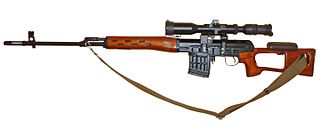
The AK-47, officially known as the Avtomat Kalashnikova, is an assault rifle that is chambered for the 7.62×39mm cartridge. Developed in the Soviet Union by Russian small-arms designer Mikhail Kalashnikov, it is the originating firearm of the Kalashnikov family of rifles. After more than seven decades since its creation, the AK-47 model and its variants remain one of the most popular and widely used firearms in the world.

Mikhail Timofeyevich Kalashnikov was a Soviet and Russian lieutenant general, inventor, military engineer, writer, and small arms designer. He is most famous for developing the AK-47 assault rifle and its improvements, the AKM and AK-74, as well as the RPK light machine gun and PK machine gun.

The AK-74 is an assault rifle designed by small arms designer Mikhail Kalashnikov in 1974 as a successor to the AKM. While primarily associated with the Soviet Union, it has been used by many countries since the 1970s. It is chambered for the 5.45×

The SVD, GRAU index 6V1, is a semi-automatic designated marksman rifle/sniper rifle chambered in the 7.62×54mmR cartridge, developed in the Soviet Union.

The GP-25 Kostyor ("Bonfire"), GP-30 Obuvka ("Shoe") and GP-34 are a family of Russian 40 mm under-barrel muzzleloaded grenade launchers for the AK family of assault rifles. The acronym GP stands for Granatomyot Podstvolnyj, "under-barrel grenade launcher" in Russian, and was adopted by Soviet forces in 1978.
The RPK, sometimes inaccurately termed the RPK-47, is a Soviet 7.62×39mm light machine gun that was developed by Mikhail Kalashnikov in the early 1960s, in parallel with the AKM assault rifle. It was created to standardize the small arms inventory of the Soviet Army, where it replaced the 7.62×39mm RPD machine gun. The RPK continues to be used by the military of the post-Soviet states and certain African and Asian nations. The RPK is also manufactured in Bulgaria, Hungary, Romania, and Serbia.
The AK-103 is an assault rifle designed by Russian small arms designer Mikhail Kalashnikov.

The AK-105 is a short barrel, carbine version of the AK-74M rifle, originally developed to replace the shorter barrelled AKS-74U. The AK-105 is chambered in 5.45×39mm ammunition and is used domestically by the Russian Army in contrast to other AK-100 series rifles.

The AS Val "Shaft" and VSS Vintorez "Thread Cutter", 6P30 and 6P29 respectively, were a Soviet-designed assault rifle featuring an integral suppressor based on the prototype RG-036 completed in 1981 by TsNIITochMash. The two rifles hereafter are referred to as the Vintorez and Val. The Vintorez and Val were developed by TsNIITochMash to replace modified general-purpose firearms, such as the AKS-74UB, BS-1, APB, and PB, for clandestine operations, much like the PSS Vul. Manufacturing began at the Tula Arms Plant after its adoption by the Armed Forces of the Soviet Union in 1987.

The two most common assault rifles in the world are the Soviet AK-47 and the American M16. These Cold War-era rifles have been used in conflicts both large and small since the 1960s. They are used by military, police, security forces, revolutionaries, terrorists, criminals, and civilians alike and will most likely continue to be used for decades to come. As a result, they have been the subject of countless comparisons and endless debate.

The Zastava M76 is a military semi-automatic designated marksman rifle developed and manufactured by Zastava Arms.
The AK-102 is a shortened carbine version of the AK-101 rifle, which was derived from the original AK-47 design and its AK-74 successor. The AK-102 is chambered to fire 5.56×45mm NATO ammunition, and is made exclusively for export purposes.

The Vepr is the first Ukrainian-made assault rifle, designed in 1993–1994 by the State Space Agency of Ukraine and announced in 2003. It is one of several bullpup conversions of the conventional Russian AK-family design, along with the Polish Kbk wz. 2005 Jantar, the Chinese Norinco Type 86S, the Russian OTs-14 Groza and the Finnish Valmet M82.

The AKM is an assault rifle designed by Soviet small arms designer Mikhail Kalashnikov in 1959. It was developed as the successor to the AK-47 adopted by the Soviet Union a decade prior.
The Saiga semi-automatic rifles are a family of Russian semi-automatic rifles manufactured by Kalashnikov Concern, which also manufactures the original AK-47 and its variants, Saiga-12 shotguns and Dragunov sniper rifle. Saiga rifles are a sport version of the Kalashnikov rifle, and are marketed for hunting and civilian use. They are sometimes referred to as Saiga Sporters.

The PSO-1 is a 4×24 telescopic sight manufactured in Russia by the Novosibirsk instrument-making factory and issued with the Russian military Dragunov sniper rifle. It was introduced on 3 July 1963 together with the Dragunov sniper rifle.

The ADS is a Russian assault rifle specially made for combat divers. It is of a bullpup layout and is chambered in the 5.45×39mm M74 round. The ADS can adapt a suppressor and optical sights.
The AK-12, "Avtomat Kalashnikova, 2012" is a Russian gas-operated assault rifle chambered in 5.45×39mm designed and manufactured by the Kalashnikov Concern, making it the fifth generation of Kalashnikov rifles.

1PN58 is the GRAU index for a Soviet designed passive night scope for a range of Soviet designed small arms and grenade launchers. 1PN is the GRAU index of night vision devices, where PN stands for Nochnoy Pritsel meaning night sight. It is also called NSPUM. or NSPU-1. The 1PN58 was introduced into Soviet service in the early 1970s and is still used by many of the Soviet Union's successor states, and has been used in numerous conflicts around the world.

The SVCh is a semi-automatic designated marksman rifle/sniper rifle chambered for fully powered cartridges developed by the Kalashnikov Concern. It is designed to replace the SVD in the Army of Russian Federation.
















